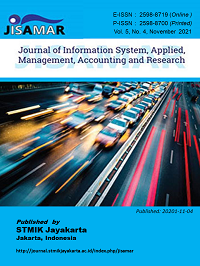Image stitching using a-kaze algorithm for borobudur panoramic on based feature
Abstract
Borobudur Temple is the largest Buddhist temple in Indonesia which has an area of 123 x 123 square meters consisting of 504 Buddha statues, 72 overlay stupas, and one main stupa, with 2,672 relief panels. Borobudur Temple also has nine platforms, six of which are square, and the remaining three are circular. Taking 2D images of Borobudur using a camera produces images that are far, small, and less clear. So we need a process of partial and overlapping image division. The process of combining multiple still images with overlapping fields of view to produce a segmented panoramic, resolution image. This method is widely used in object reconstruction. In this paper, we present a learning-based approach using the A-KAZE algorithm on the image merging process. The test results have been successfully carried out but the quality of the final result is highly dependent on the input image. A good input image has a fairly high intensity and has many objects in it, so it has many features found. Our approach directly estimates feature locations between image paired boundaries by maximizing the image-patch similarity metric between images. A collection of high-resolution images was collected for training and evaluation. The experimental results illustrate that the inner feature approach is better. This method can describe an image with a certain key point, where each key point has a gradient orientation (GO) and a gradient scale (GM) which is processed into features in the image registration process. The purpose of this study is to match images that have been cut off and in the process of merging they are still overlapping. The results of this study are that images that are split into two can be combined with image stitching.
Downloads
References
[2] H. Setyawan et al., “KAJIAN PENCOCOKAN KEPALA ARCA BUDDHA CANDI BOROBUDUR TAHAP II Hari Setyawan, Agus Hendratno, Marsis Sutopo, Jati Kurniawan, Puji Santosa, Irawan Setiyawan,” vol. XI, pp. 4–24, 2017.
[3] T. Sejarah, D. I. Sekolah, M. Pertama, S. Palembang, O. Herianto, and A. Zamhari, “RAGAM MOTIF FLORA PADA CANDI BUMIAYU SEBAGAI SUMBER PEMBELAJARAN IPS TERPADU (SEJARAH) DI SEKOLAH MENENGAH PERTAMA SRIGUNA PALEMBANG Oleh: Herianto*, Sukardi**, Ahmad Zamhari*** *,” 2011.
[4] H. Xia, J. Tan, and K. Wu, “Colored Structured Light Patterns with Binocular Cameras for Fast and Low-cost 3-D Reconstruction,” 2019 IEEE 2nd International Conference on Computer and Communication Engineering Technology, CCET 2019. pp. 26–30, 2019, doi: 10.1109/CCET48361.2019.8989393.
[5] R. Arun Kumar, K. Sathesh Kumar, T. Prasanth, and K. Balakrishnan, “The feature based image stitching techniques,” Int. J. Recent Technol. Eng., vol. 8, no. 2, pp. 5543–5547, 2019, doi: 10.35940/ijrte.B3344.078219.
[6] J. Sun, Y. Ding, X. Zhu, J. Xi, and Y. D. Zhang, “Extended Gaussian sphere and similarity fusion method for reassembly of 3D cultural relics,” Multimed. Tools Appl., vol. 79, no. 41–42, pp. 30187–30203, 2020, doi: 10.1007/s11042-020-09535-9.
[7] C. Papaodysseus et al., “Efficient solution to the 3D problem of automatic wall paintings reassembly,” Comput. Math. with Appl., vol. 64, no. 8, pp. 2712–2734, 2012, doi: 10.1016/j.camwa.2012.08.003.
[8] Y. Zhang, K. Li, X. Chen, S. Zhang, and G. Geng, “A multi feature fusion method for reassembly of 3D cultural heritage artifacts,” J. Cult. Herit., vol. 33, no. 2017, pp. 191–200, 2018, doi: 10.1016/j.culher.2018.03.001.
[9] Z. Qu, W. Bu, and L. Liu, “The algorithm of seamless image mosaic based on A-KAZE features extraction and reducing the inclination of image,” IEEJ Trans. Electr. Electron. Eng., vol. 13, no. 1, pp. 134–146, 2018, doi: 10.1002/tee.22507.
[10] P. F. Alcantarilla, A. Bartoli, and A. J. Davison, “KAZE features,” Lect. Notes Comput. Sci. (including Subser. Lect. Notes Artif. Intell. Lect. Notes Bioinformatics), vol. 7577 LNCS, no. PART 6, pp. 214–227, 2012, doi: 10.1007/978-3-642-33783-3_16.
[11] S. Mistry and A. Patel, “Image Stitching using Harris Feature Detection,” Int. Res. J. Eng. Technol., vol. 03, no. 04, pp. 1363–1369, 2016, [Online]. Available: www.irjet.net.
[12] V. D. Hoang, D. P. Tran, N. G. Nhu, T. A. Pham, and V. H. Pham, “Deep Feature Extraction for Panoramic Image Stitching,” Lect. Notes Comput. Sci. (including Subser. Lect. Notes Artif. Intell. Lect. Notes Bioinformatics), vol. 12034 LNAI, pp. 141–151, 2020, doi: 10.1007/978-3-030-42058-1_12.
[13] S. K. Sharma and K. Jain, “Image Stitching using AKAZE Features,” J. Indian Soc. Remote Sens., vol. 48, no. 10, pp. 1389–1401, 2020, doi: 10.1007/s12524-020-01163-y.
[14] M. Zhang et al., “Fast algorithm for 2D fragment assembly based on partial EMD,” Vis. Comput., vol. 33, no. 12, pp. 1601–1612, 2017, doi: 10.1007/s00371-016-1303-3.
[15] A. Jenitta, G. Abinandhini, M. Geerthanadevi, and M. Latha, “A Fast Panorama Stitching Method of Image Sequence,” J. Electron. Commun. Eng., pp. 58–63, 2017.

This work is licensed under a Creative Commons Attribution 4.0 International License.








_uk501.png)

.2022-2026_uk200_pxl_.jpg)















.png)
3.png)


